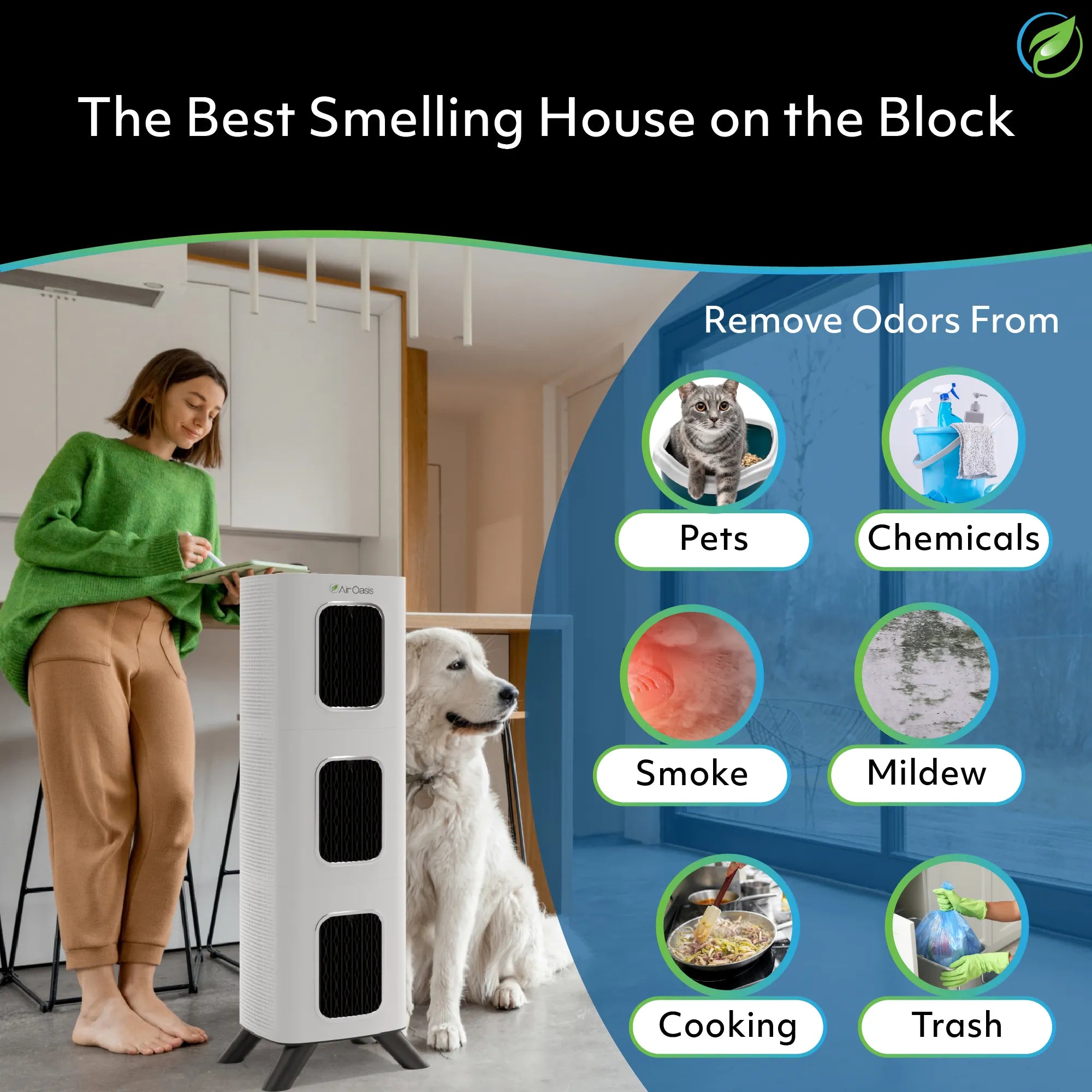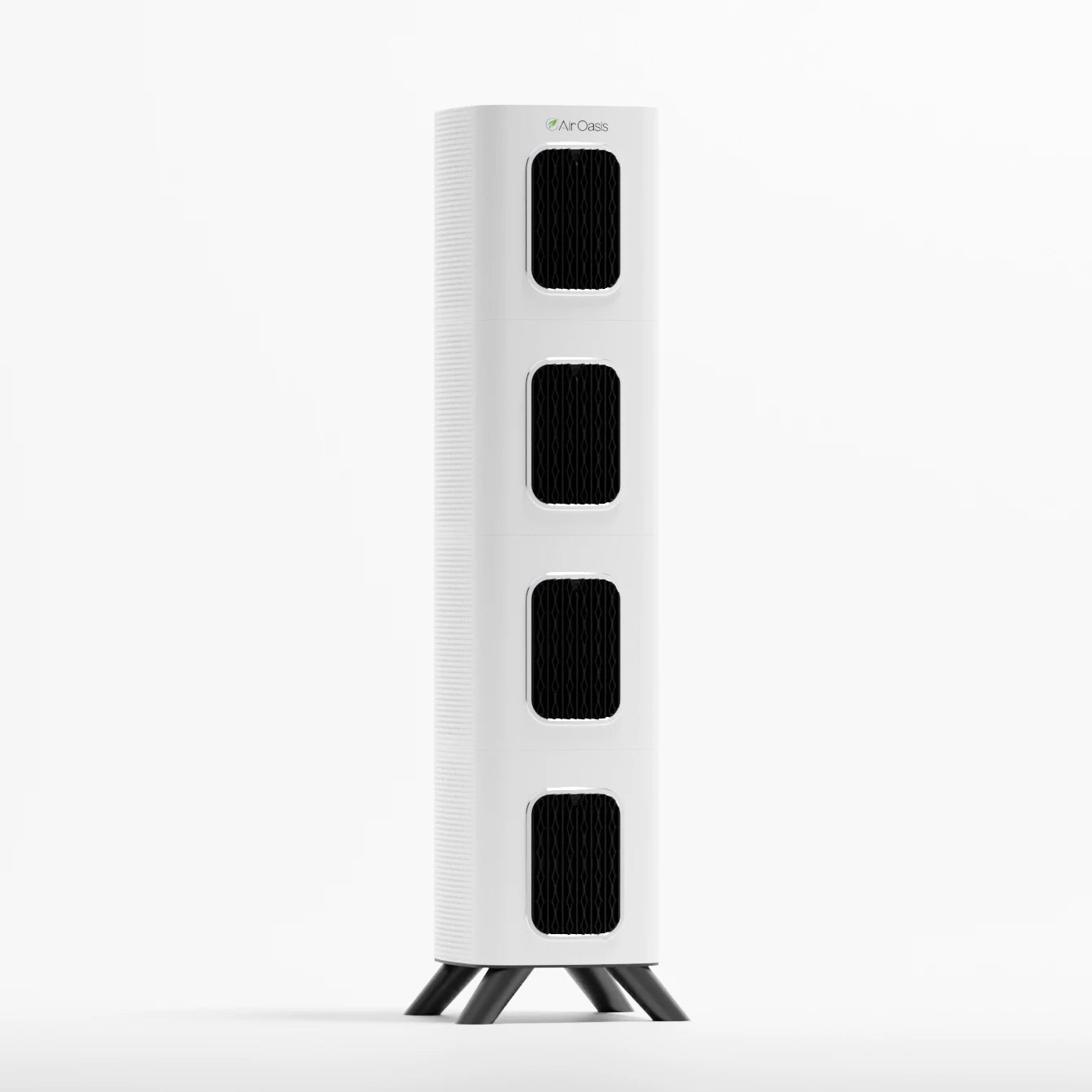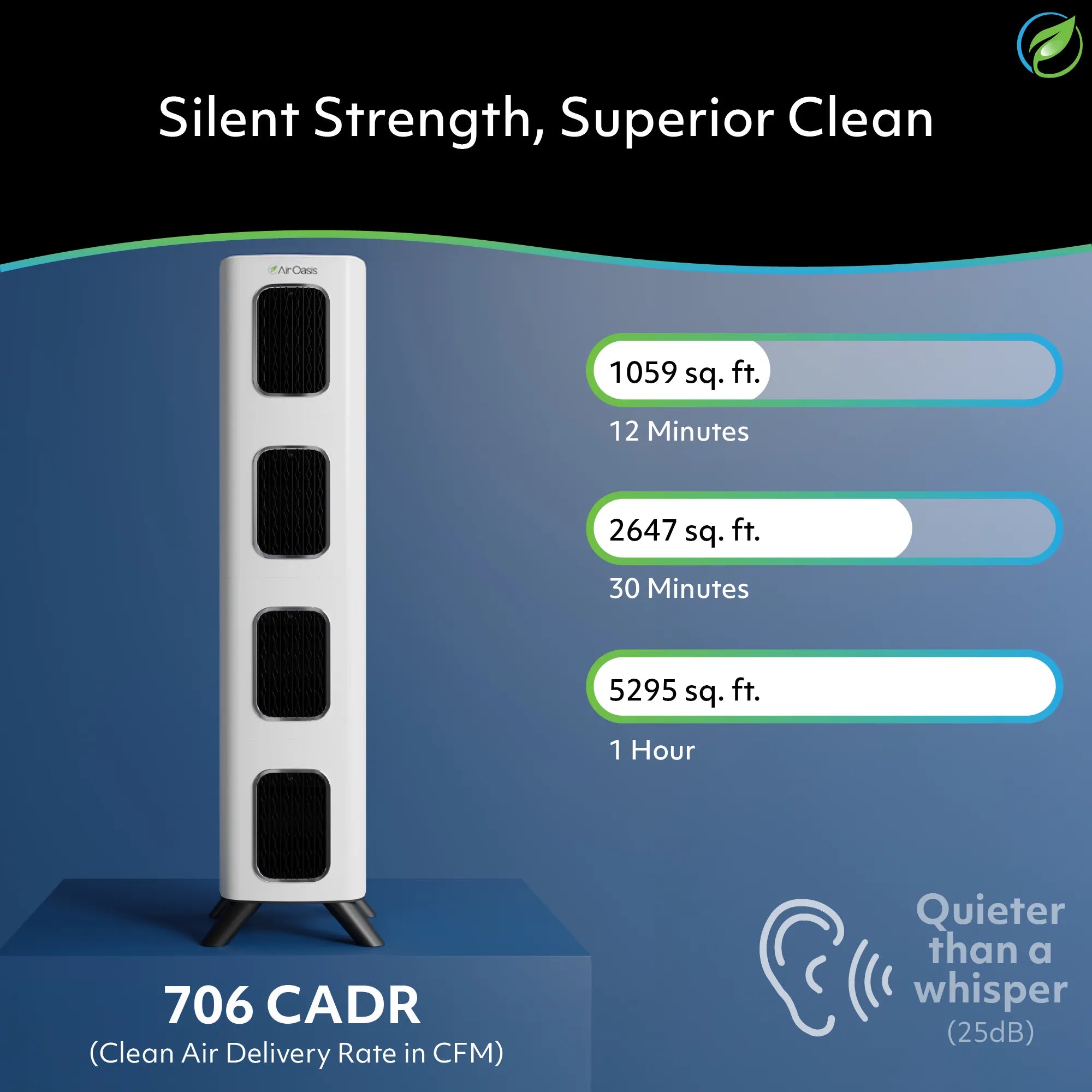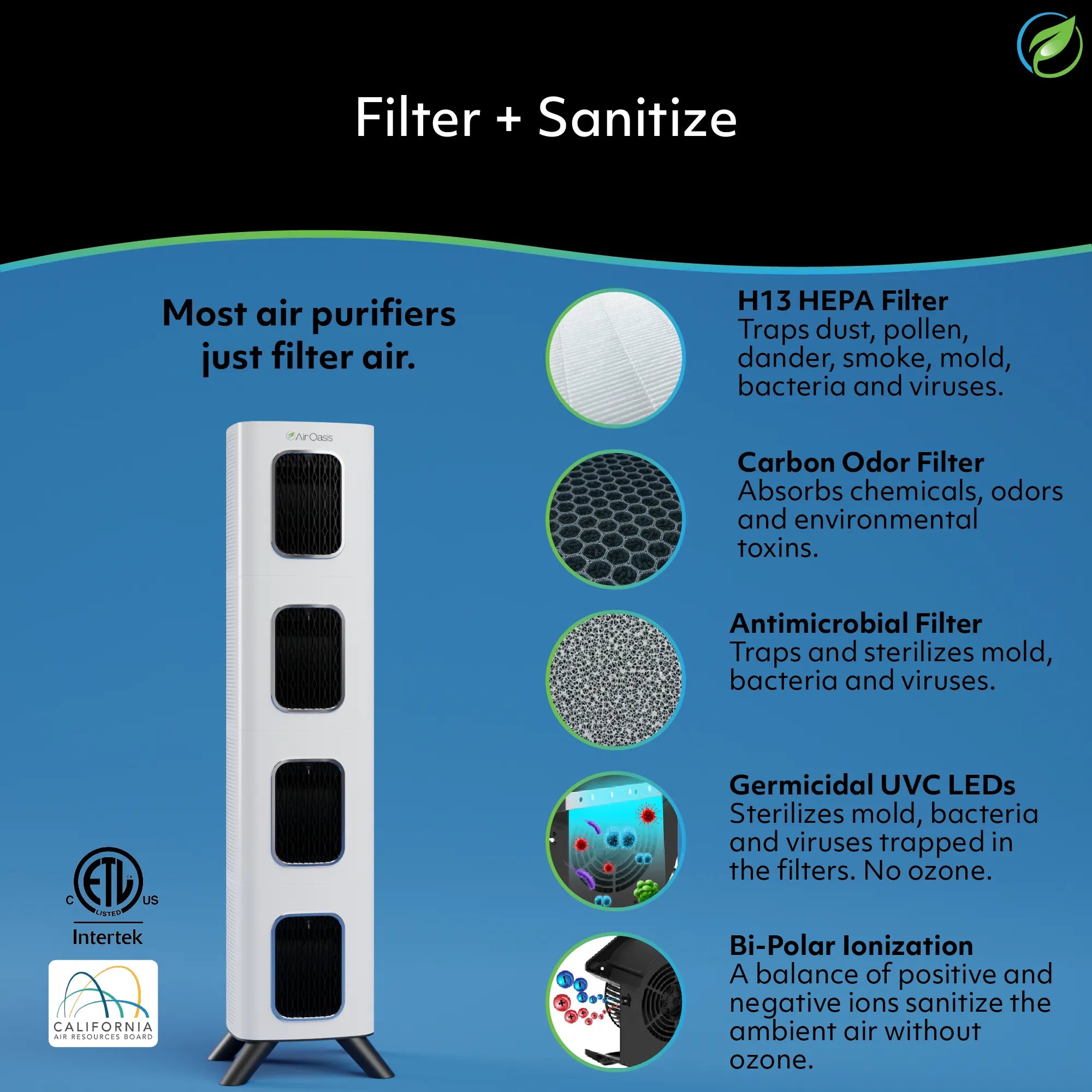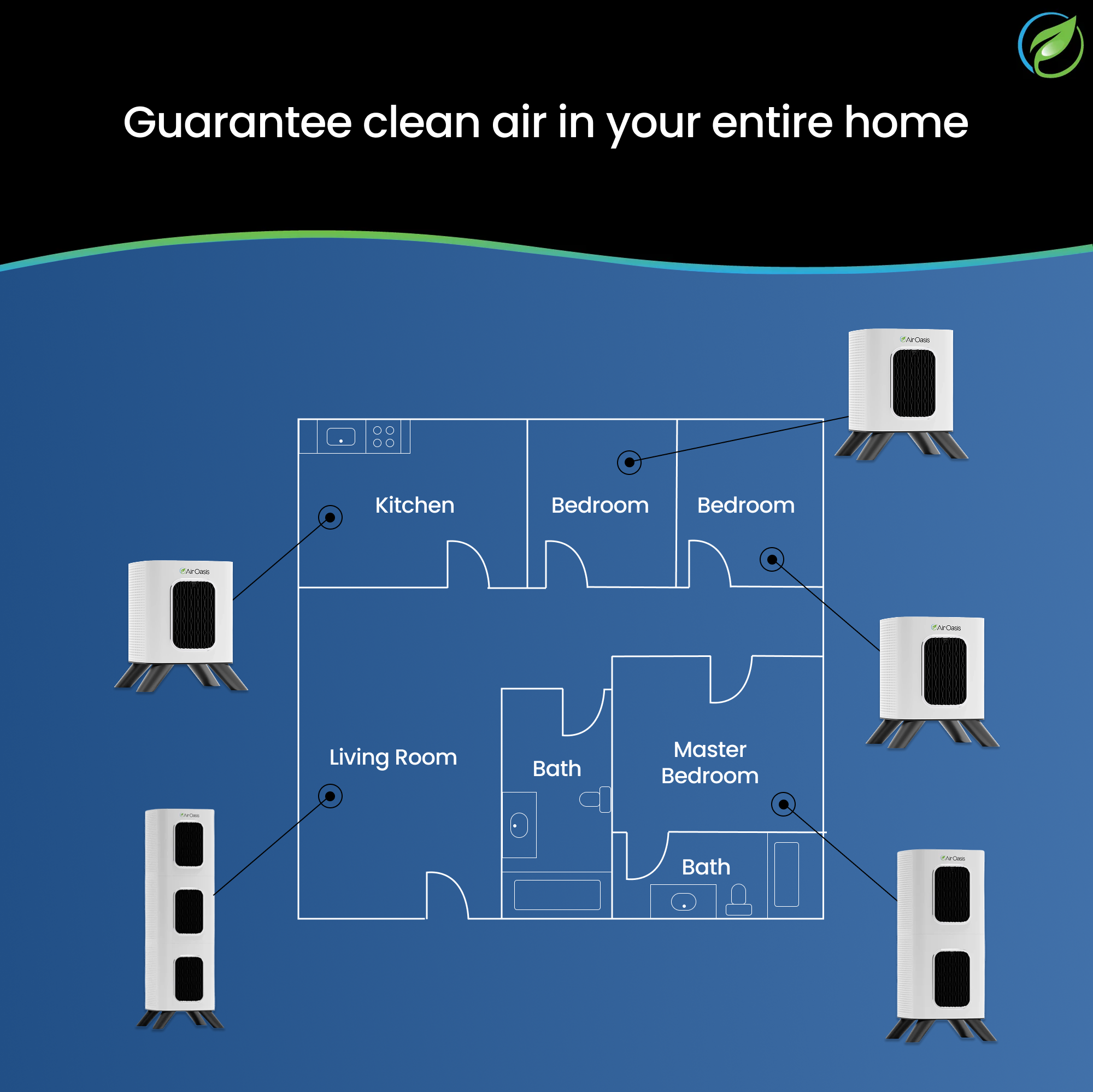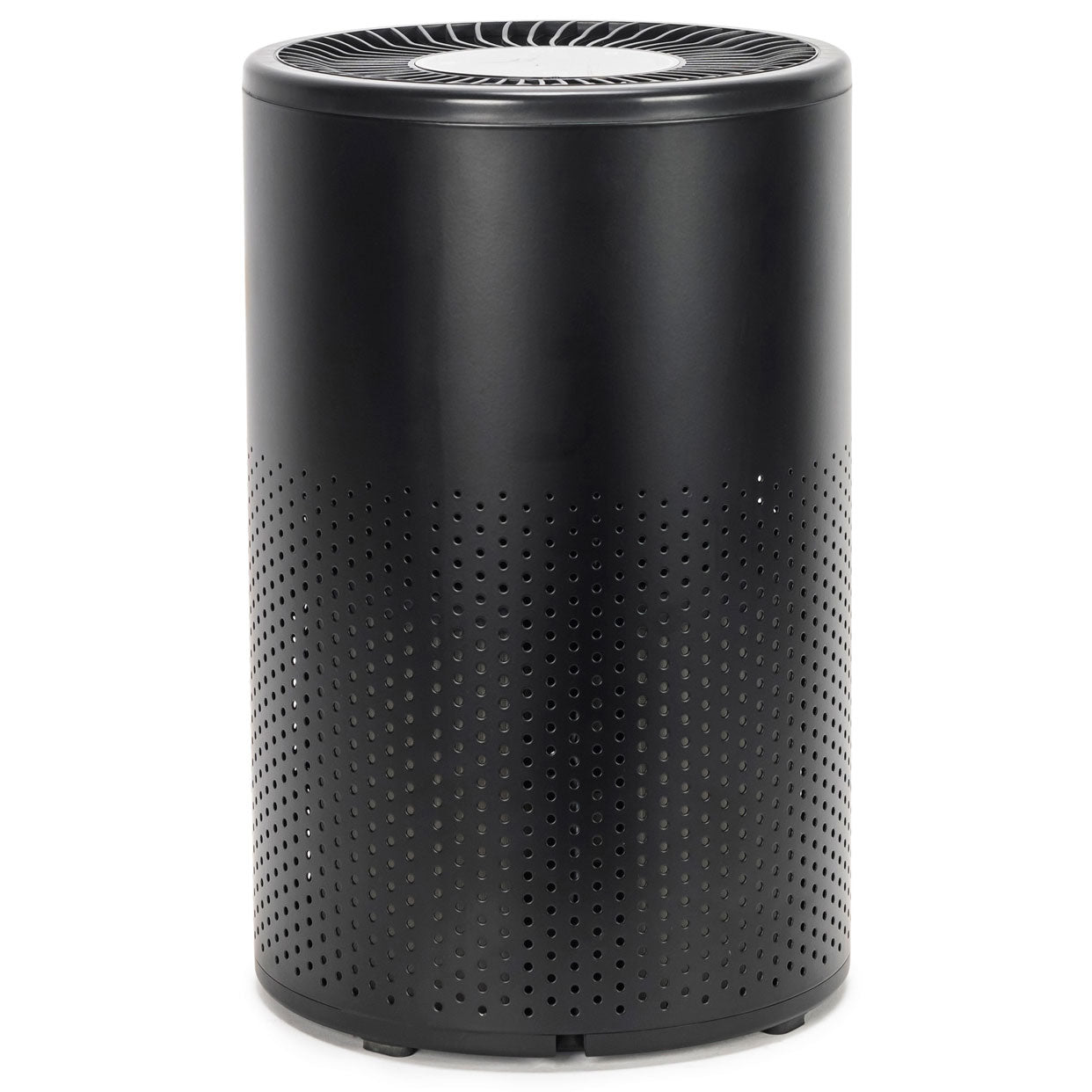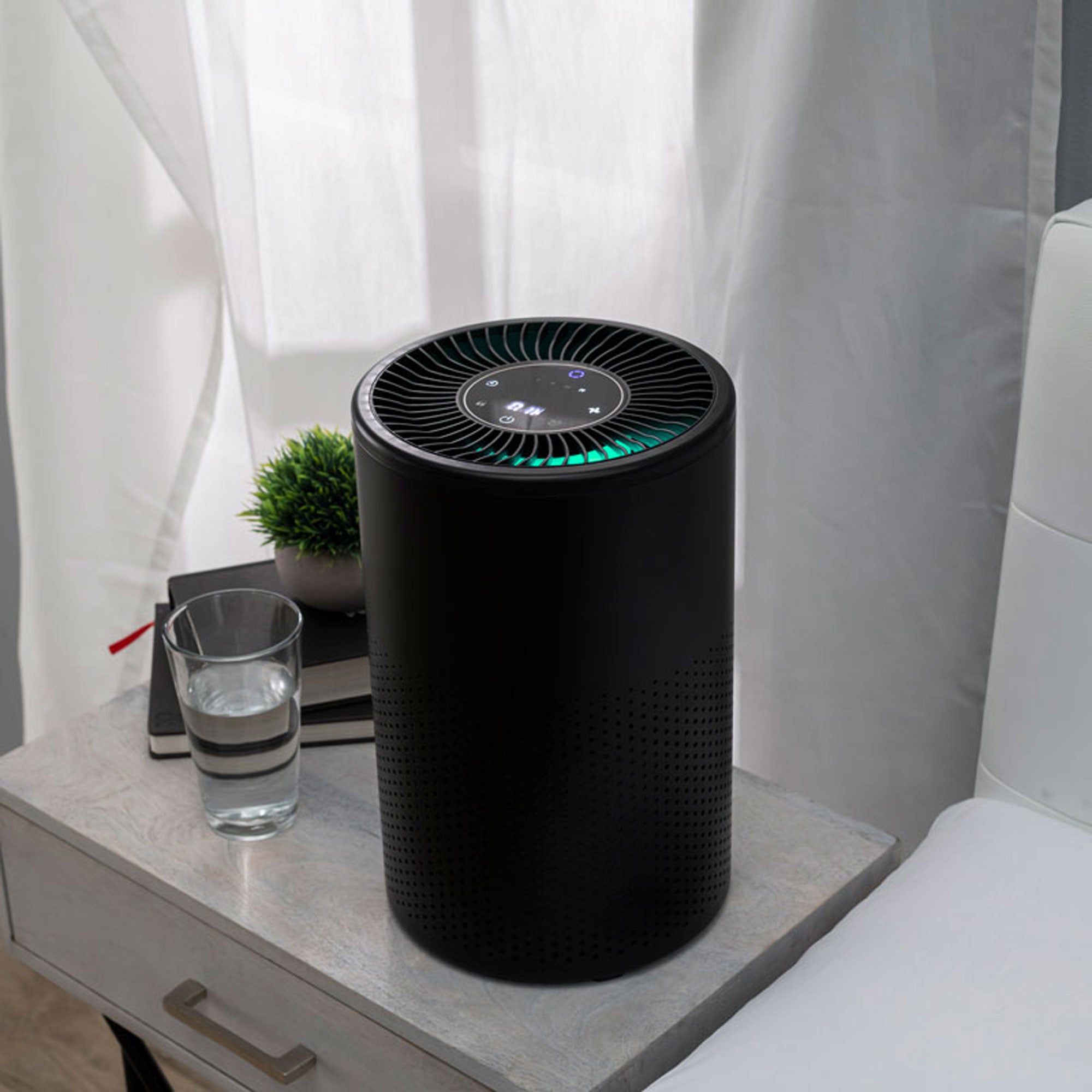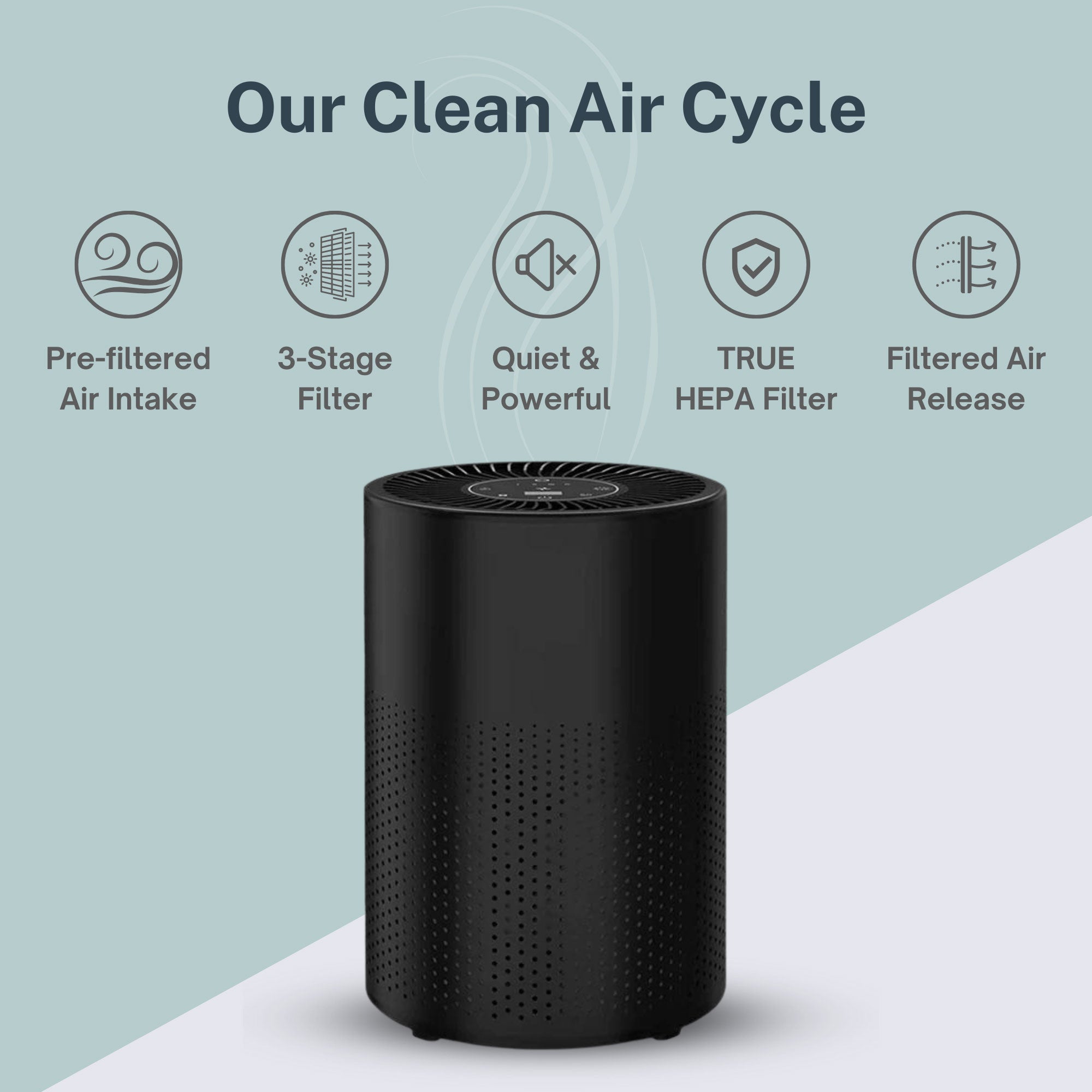The COVID-19 pandemic necessitated many lifestyle changes, including wearing masks, social distancing and choosing outdoor activities over indoor ones. Many people took these precautions in an effort to avoid the virus and ended up avoiding the cold and flu season, too. At a time with increased emphasis on indoor air quality, Air Oasis is proud to offer air purifiers for any space and every concern.
Amid the return to the physical workspace, some companies are prioritizing their employees’ health by providing air purifiers for the office. The Occupational Safety and Health Administration (OSHA) requires employers to provide a safe and healthy workplace and urges employers to follow the guidelines laid out by the Centers for Disease Control and Prevention (CDC), which includes the use of air purifiers.
In addition to enforcing workplace air quality laws, the federal government regulates National Ambient Air Quality Standards. The Environmental Protection Agency (EPA) sets federal standards for air quality with laws like the Clean Air Act.
History of Clean Air Act and Amendments
More than 50 years ago, the United States Congress passed the 1970 Clean Air Act in an effort to control common industrial pollutants like sulfur dioxide and nitrogen oxides. The passage of the act and its subsequent amendments dramatically improved air quality across the country. In 1990, Congress passed sweeping amendments that addressed acid rain, urban air pollution and toxic emissions. Each state in the country must comply with the regulations laid out in the Clean Air Act.
Despite the vast improvement, recent data shows an uptick in air pollution once again. After declining by more than 24% from 2009 to 2016, fine particulate matter (in counties with monitors across the U.S.) increased 5.5% from 2016 to 2018, indicating the necessity of continued efforts in mitigating air pollution.
Although the Clean Air Act regulates ambient air quality, it doesn’t regulate indoor air quality. Indoor air quality is regulated on a state-by-state basis. Outdoor pollution can be a primary cause of indoor air problems, which itself varies by state. One regulatory body is at the forefront of clean air efforts.
Office of Air and Radiation (OAR)
The Office of Air and Radiation (OAR) is responsible for administering the Clean Air Act and developing policies, national programs and regulations to control pollution and radiation exposure. OAR isn’t only concerned with outdoor air quality; the organization works to improve indoor air quality as well.
After compiling data on air pollution, OAR reports its findings to Congress and makes that information available to the public. The organization assists state and local agencies by monitoring air pollution and developing regulations to improve air quality.
You may wonder, “what are the laws about clean air in my state?”
Continue reading or scroll through to find out.
Alabama
In 2003, Alabama adopted the Clean Indoor Air Act, which prohibited smoking in most public places. Its Indoor Air Quality Program provides individuals with information and support based on the EPA’s mold and moisture guidelines.
Alaska
The Alaska Division of Air Quality manages an air permit program, monitors air quality and ensures compliance with federal regulations. State laws prohibit smoking and vaping in enclosed public places and places of employment.
Arizona
The Air Quality Division protects the environment by conducting air quality forecasting, monitoring and analyzing data, issuing permits, compliance inspections and more. The State Implementation Plan (SIP) keeps track of all air pollution strategies, state statutes and rules implemented under the federal Clean Air Act.
Arkansas
In 2006, state officials created the Arkansas Clean Indoor Air Act in an effort to protect workers from secondhand smoke. The Office of Air Quality handles permits, compliance, policy and planning, and asbestos and enforcement.
California
The California Environmental Protection Agency is a cabinet-level agency within the state government. Within the CalEPA, the California Air Resources Board ensures the state is achieving federally mandated air quality standards and state initiatives. The state prohibits smoking indoors practically everywhere.
Colorado
The General Assembly passed the Colorado Clean Indoor Air Act in 2006, which prohibited smoking in indoor areas throughout the state. It was amended in 2013 and 2019 to prohibit smoking marijuana and electronic cigarettes, respectively. The Air Pollution Control Division regulates all air quality issues.
Connecticut
The Connecticut Department of Energy and Environmental Protection (DEEP) makes sure the state attains and maintains EPA standards laid out in the federal Clean Air Act. In 1986, the state adopted the most comprehensive regulation (at the time) of toxic air pollutants, establishing emission limits for 850 chemicals. It prohibits smoking in most indoor places.
Delaware
The Delaware Division of Air Quality monitors and regulates all emissions to the air, as well as develops the state’s implementation plan of the Clean Air Act. Delaware adopted the Clean Indoor Air Act in 2002, restricting indoor smoking in most public places.
Florida
The Florida Department of Environmental Protection monitors the air to ensure emission sources are compliant with the federal Clean Air Act. In 1985, it enacted the Florida Clean Indoor Air Act, prohibiting smoking indoors.
Georgia
The Air Protection Branch of Georgia’s Environmental Protection Division monitors more than 200 pollutants at 34 sites in 25 counties across Georgia. It collects and publishes data, issues Smog Alerts and ensures the state is complying with the federal Clean Air Act. In 2005, it signed the Smokefree Air Act into law, prohibiting smoking indoors in most public places.
Hawaii
Although this state is known for its great air quality, it does have some air pollution, which is monitored by the Clean Air Branch. As of 2016, state laws prohibit smoking (including electronic smoking devices) in most public places.
Idaho
The Air Quality Division of the Idaho Department of Environmental Quality enforces the air quality regulations outlined in the Clean Air Act. Title 39, Chapter 55 of the Idaho Code Statutes bans smoking in public places.
Illinois
The Illinois Environmental Protection Agency’s Bureau of Air monitors ambient air quality, develops plans for achieving new air quality standards, issues permits and complies with federal regulations. State laws include the Indoor Air Quality Act, the Mold Remediation Registration Act and the Environmental Toxicology Act.
Indiana
Indiana’s Indoor Air Quality program functions to enforce 410 IAC 33, “Indoor Air Quality in Schools and State Agencies,” and provide assistance to local health departments investigating and educating the public about indoor air quality. In 2012, Indiana introduced the State Smoke Free Air Law, banning smoking in almost every public place.
Iowa
The Air Quality Bureau develops air quality rules and regulations consistent with state and national standards. In 2008 it issued the Smokefree Air Act, prohibiting smoking in enclosed workspaces and some outdoor spaces.
Kansas
The Kansas Bureau of Air monitors air quality and emissions, issues permits and attempts compliance with state and national air quality regulations. However, the metropolitan Kansas City area typically experiences 10 to 15 days each year on which air quality does not comply with national standards, which could result in a new, EPA-mandated regulatory plan.
Kentucky
The Division for Air Quality measures air quality, issues permits and monitors emission, asbestos, open burning and more. Kentucky does not have a statewide smoking ban; cities can choose to be smoke-free.
Louisiana
The Louisiana Department of Environmental Quality and EPA’s South Central Region implement programs to carry out the Clean Air Act in Louisiana. Although smoking is prohibited in all government buildings and many public workplaces, it is not restricted in bars.
Maine
The Maine Department of Environmental Protection implements air quality programs and enforces air quality laws across the state of Maine. Under Maine law, indoor workplaces, restaurants, bars, outdoor dining areas, state parks, beaches and historical sites, and other public places are required to be smoke-free.
Maryland
Maryland’s Department of the Environment monitors air quality compliance, permitting and planning according to the federal Clean Air Act and state requirements. The Clean Indoor Air Act of 2007 prohibits smoking in practically all indoor workspaces.
Massachusetts
The Massachusetts Department of Environmental Protection enforces the federal Clean Air Act, as well as the Massachusetts Clean Air Act, both of which serve to prevent pollution and contamination of the atmosphere.
Michigan
The Michigan Department of Environment, Great Lakes and Energy regulates sources of air pollutants to minimize damage done to human health and the environment. In 2010, Michigan implemented its Smoke-Free Indoor Air Law, prohibiting smoking in most public places.
Minnesota
The Minnesota Clean Indoor Air Act was enacted in 1975 in an effort to protect public health by prohibiting smoking around children and injured people. It’s been amended multiple times since and now prohibits smoking and vaping in practically all indoor public places and places of employment. It is enforced by the Minnesota Department of Health.
Mississippi
The Mississippi Department of Environmental Quality’s Air Division is charged with “controlling, preventing, and abating air pollution” to achieve compliance with the Mississippi Air and Water Pollution Control Act, applicable regulations from the EPA and federal Clean Air Act. The state does not prohibit smoking in private workplaces.
Missouri
Missouri’s Air Pollution Control Program monitors air pollutants and enforces the federal Clean Air Act, as well as the Missouri Air Conservation Law. Missouri only restricts smoking in some workplaces.
Montana
The Montana Department of Environmental Quality is in charge of meeting federal standards outlined in the Clean Air Act. As of 2009, the Montana Clean Indoor Air Act required all enclosed public places and workplaces to be smoke-free.
Nebraska
Nebraska’s Air Quality Division develops and enforces air quality laws based on the federal Clean Air Act and the Nebraska Environmental Protection Act. The Nebraska Clean Indoor Air Act prohibits smoking and the use of e-cigarettes in public places and workplaces.
Nevada
The Bureaus of Air Pollution Control and Air Quality Planning (part of the Nevada Division of Environmental Protection) work to tackle air challenges in Nevada, as well as implement strategies to improve air quality. The Nevada Indoor Air Act prohibits smoking in most indoor areas.
New Hampshire
The New Hampshire Department of Environmental Services is responsible for achieving and maintaining the state’s air quality. The Indoor Smoking Act regulates smoking in enclosed places.
New Jersey
New Jersey’s Division of Air Quality monitors emissions and inventories their sources, models air quality and conducts risk assessment. The state’s Smoke-Free Air Act of 2006 ensures that workers have a smoke-free workplace.
New Mexico
The Air Quality Bureau of New Mexico enforces state and federal air quality regulations. The Dee Johnson Clean Indoor Air Act prohibits smoking and vaping (both tobacco and cannabis) in most indoor places, including stores, restaurants, bars and other workplaces.
New York
The Department of Environmental Conservation’s Air Quality Monitoring Program tracks New York’s air quality and monitors pollution. The New York State Clean Indoor Air Act prohibits indoor smoking and vaping in all public places and businesses with employees.
North Carolina
North Carolina’s Division of Air Quality operates a statewide air quality monitoring network to measure pollutants and meet air quality initiatives. The state prohibits smoking in certain public places and certain places of employment.
North Dakota
The North Dakota Division of Air Quality enforces state and federal environmental laws through permitting, inspection, sampling, monitoring and other analytic services. The state voted to become smoke-free in 2012, prohibiting smoking in all enclosed public places.
Ohio
The Ohio Division of Air Pollution Control develops and enforces rules to meet regulations laid out in the federal Clean Air Act. Ohio voters approved a smoking ban in 2006 that prohibited smoking in public places and places of employment.
Oklahoma
The Air Quality Division of Oklahoma’s Department of Environmental Quality operates several programs to carry out regulatory duties under state and federal law. Oklahoma still allows smoking in some restaurants and bars.
Oregon
Oregon’s Department of Environmental Quality measures air pollution across the state and ensures its residents are breathing air that meets federal air quality standards. Oregon’s Indoor Clean Air Act prohibits smoking in almost all public indoor spaces.
Pennsylvania
The Bureau of Air Quality is responsible for achieving the standards set by the federal Clean Air Act, as well as the Pennsylvania Air Pollution Control Act. The Clean Indoor Air Act of 2008 prohibits smoking in a public place or workplace.
Rhode Island
The Office of Air Resources protects and promotes the air quality in Rhode Island by adhering to state and federal regulations. Rhode Island prohibits smoking in public places.
South Carolina
The South Carolina Department of Health and Environmental Control regulates air quality according to state and federal standards by monitoring, modeling and reporting air pollution. The state bans smoking in all public indoor places, as well as some parks and beaches.
South Dakota
The South Dakota Air Quality Program monitors ambient air quality across the state, issues permits and complies with state and federal regulations. The state bans smoking in public buildings and workplaces, including bars and casinos.
Tennessee
The Tennessee Division of Air Pollution Control is charged with establishing emissions standards and procedure requirements for industries across the state. Tennessee bans indoor smoking in most, but not all, public places.
Texas
The Texas Commission on Environmental Quality monitors air quality and emissions, issues permits and ensures compliance with state and federal regulations. Texas does not have a statewide, comprehensive smoking ban, but many cities within the state do.
Utah
The Utah Division of Air Quality maintains standards outlined in the Utah Air Conservation Act, as well as the federal Clean Air Act. The Utah Indoor Clean Air Act prohibits smoking in all enclosed indoor places of public access.
Vermont
The Vermont Department of Environmental Conservation enforces the Vermont Air Pollution Control Regulations, as well as federal regulations. Vermont bans smoking in nearly all public places.
Virginia
The Virginia Department of Environmental Quality adheres to the Air Pollution Control Law of Virginia and the federal Clean Air Act. The state bans smoking in most public places.
Washington
Washington State’s Department of Ecology regulates harmful emissions and works to reduce greenhouse gasses that increase global temperatures. In 2005, Washington adopted a comprehensive smoke-free workplace act.
West Virginia
The West Virginia Division of Air Quality maintains ambient air quality by enforcing state and federal regulations. There is no statewide smoking ban.
Wisconsin
The Wisconsin Department of Natural Resources monitors air quality trends and pollution, regulating ambient air quality in adherence with state and federal regulations. Wisconsin’s Smoke-Free Air Law prohibits smoking in indoor public places.
Wyoming
The Air Quality Division of Wyoming conducts permitting, monitoring and inspection in order to preserve ambient air quality. The state has no smoking restrictions for private workplaces.
Get Cleaner Indoor Air With Air Purifiers
The 1970 Clean Air Act and its subsequent amendments addressed many of the ambient air quality issues plaguing the U.S. Although the act doesn’t regulate indoor air quality, ambient air quality is one of the largest factors affecting indoor air quality. No matter where you live, you can improve your indoor air quality by using a highly effective air purifier.
Shop Air Oasis purifiers today and start breathing easier.





























